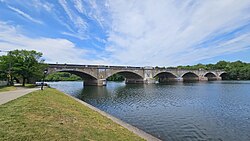Columbia Railroad Bridge | |
|---|---|
 The bridge in 2023 | |
| Coordinates | 39°59′08″N 75°12′13″W / 39.98556°N 75.20361°W |
| Carries | CSX Trenton Subdivision |
| Crosses | Kelly Drive, Schuylkill River, Dr. Martin Luther King, Jr. Drive |
| Locale | Philadelphia, Pennsylvania |
| Other name(s) | Columbia Bridge |
| Characteristics | |
| Design | Arch bridge, closed spandrel[1] |
| Material | Concrete |
| Total length | Total length between face abutments is 971 feet 3 7/8 inches.[2] |
| Width | Total width under coping is 57 feet 6 inches.[2] |
| No. of spans | 8 |
| History | |
| Designer | Samuel Tobias Wagner, Chief Engineer for the Philadelphia & Reading Railway[3] |
| Constructed by | Pennsylvania & Reading Railway, with contracts for grading and the construction of the masonry, including the foundations, were placed with Messrs. Seeds & Derham, of Philadelphia. The waterproofing was done under contract with the Minwax Company of New York. The removal of the old wrought iron superstructure was by Henry Hitner & Sons, Philadelphia.[4] |
| Construction start | July 1917[4] |
| Opened | Railroad traffic first crossed on two tracks 24 March 1920 at 11 am. The completion of the bridge, rail traffic all four tracks, was 11 October 1921.[5] |
| Location | |
 | |
Columbia Railroad Bridge, also known as Columbia Bridge, is a 1920 concrete arch bridge in Philadelphia, Pennsylvania, that carries CSX Trenton Subdivision rail lines over the Schuylkill River.[6] Located in Fairmount Park, upstream of the Pennsylvania Railroad Connecting Bridge, it is the third railroad bridge at the site. Near its east abutment are the Schuylkill Grandstand (for viewing rowing regattas) and the John B. Kelly statue.
- ^ "The Reconstruction of the Columbia Bridge," by Samuel Tobias Wagner, Transactions of the Wagner Free Institute of Science of Philadelphia, Volume X, October 1923, pp.19–20.
- ^ a b "The Reconstruction of the Columbia Bridge," by Samuel Tobias Wagner, Transactions of the Wagner Free Institute of Science of Philadelphia, Volume X, October 1923, p. 19.
- ^ "The Reconstruction of the Columbia Bridge," by Samuel Tobias Wagner, Transactions of the Wagner Free Institute of Science of Philadelphia, Volume X, October 1923, pp. 15–27.
- ^ a b "The Reconstruction of the Columbia Bridge," by Samuel Tobias Wagner, Transactions of the Wagner Free Institute of Science of Philadelphia, Volume X, October 1923, p. 26.
- ^ "The Reconstruction of the Columbia Bridge," by Samuel Tobias Wagner, Transactions of the Wagner Free Institute of Science of Philadelphia, Volume X, October 1923, p. 25.
- ^ Columbia Bridge (Sign). Under the bridge along West River Drive, near Montgomery Drive: Fairmount Park Commission.